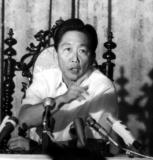|
 BATAS
MILITAR BATAS
MILITAR
(Martial Law)
(September 21, 1972
- January 17, 1981)
SOURCES
|
HUMAN RIGHTS VIOLATIONS
OF THE MARCOS REGIME |
extrajudicial killings
|
3,257
|
| |
2,520
or 77% of the victims were "salvaged" |
|
tortured |
35,000 |
|
incarcerated |
70,000 |
|
disappeared |
737
|
| |
(between 1975 and 1985) |
|
Source: "Dark
Legacy: Human rights under the Marcos regime" by Alfred McCoy |
TIMELINE
September 13, 1972
(Wednesday)
September 22, 1972
(Friday)
-
Before 9 p.m. - As
Defense Secretary Juan Ponce Enrile was on his way home to Dasmariņas
Village in Makati, a carload of gunmen intercepted one of the cars in
his convoy and riddled it with 30 shots. But Enrile was riding with
security men in a second car, so he was not hurt. The gunmen--tagged by
the Marcos regime as "communist terrorists"--escaped. In February 1986, Enrile
admitted the ambush was staged.
-
9 p.m. - Marcos
called the ambush on Enrile "the last straw," and signed Proclamation
1081, which placed the entire country under martial law.
(The actual
document was dated September 21, 1972 because Marcos believed his lucky number
was 7, and 21 was divisible by 7. Other accounts say the document was
actually signed September 17.)
September 23, 1972
(Saturday)
|
Arrested when martial law was declared |
- Sen. Benigno "Ninoy" Aquino
- Sen. Jose Diokno
- Sen. Francisco "Soc" Rodrigo
- Ramon Mitra
- Sergio Osmeņa, Jr.
- businessman Eugenio Lopez, Jr.
- teacher Etta Rosales
- lawyer Haydee Yorac
- publisher Joaquin Roces
- publisher Teodoro Locsin
- Amando Doronilla, Daily Mirror
- Rosalinda Galang, Manila Times
- Bobby Ordonez, Philippines
Herald
- Ernesto Granada, Manila
Chronicle
- Manuel Almario, Philippine News
Service
- Luis Beltran, Evening News
- Rolanda Fadul, Taliba
- Juan Mercado, Press Foundation
of Asia
- Luis R. Mauricio, Graphic
magazine
- Ninotchka Rosca,
Asia-Philippines Leader
- Napoleon Rama, Philippines Free
Press
- Amelita Reysio-Cruz, gossip
columnist
- George Sison, gossip columnist
- broadcaster Jose Mari Velez
- broadcaster Roger Arrienda
|
-
1 a.m. to 4 a.m. -
Marcos ordered the arrest of his political opponents, the closure
of schools and communication, and the government takeover of public
utilities.
-
6 a.m. - "In the
morning of September 23, people awoke without a newspaper on their
doorsteps and with only the hiss of empty air over their radios."*
-
3 p.m. - Press
Secretary Francisco Tatad went on air. It was the first time the
nation learned of Proclamation 1071
-
7 p.m. - Marcos went on air to
formally announce the proclamation of martial law. He imposed curfew
and banned public demonstrations.
January 17, 1981 (Saturday)
-
Marcos issued Proclamation No. 2045,
proclaiming the termination of the state of martial law throughout the
Philippines. He also inaugurated the "New Republic" but retained all
martial law decrees, orders, and law-making powers through Amendment
Six to the Consitution. The formal termination of martial law was
timed with the election of US PResident Ronald Reagan and the planned
visit of Pope John Paull II in February 1981.
|